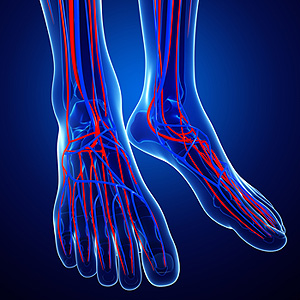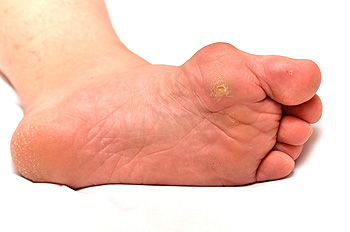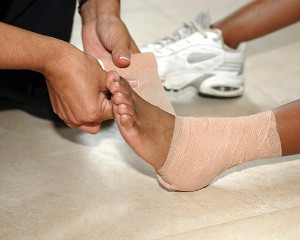January 2019
High Heels and Morton’s Neuroma
 High heels have become a normal part of many women's lives. Unfortunately, wearing high heels too often can lead to health complications. One of these health complications is Morton’s neuroma, which is a complication involving swelling along a nerve in the foot. This swelling results in burning pain, numbness, and tingling. This affliction is more common in women than men, which might be because it is more common for women to wear high heels. High heels put the foot in an unnatural position and push toes together. Wearing high heels often, can lead to subtle bone shifts that increase the risk for a neuroma to form. Usually, the discomfort caused by this condition can be briefly relieved by taking off your shoes and moving your feet around. Continuing to wear high heels for extended periods of time will aggravate your foot and cause the symptoms to come back. If you feel that you may have a Morton’s neuroma, then it is suggested you speak with a podiatrist about proper treatment methods.
High heels have become a normal part of many women's lives. Unfortunately, wearing high heels too often can lead to health complications. One of these health complications is Morton’s neuroma, which is a complication involving swelling along a nerve in the foot. This swelling results in burning pain, numbness, and tingling. This affliction is more common in women than men, which might be because it is more common for women to wear high heels. High heels put the foot in an unnatural position and push toes together. Wearing high heels often, can lead to subtle bone shifts that increase the risk for a neuroma to form. Usually, the discomfort caused by this condition can be briefly relieved by taking off your shoes and moving your feet around. Continuing to wear high heels for extended periods of time will aggravate your foot and cause the symptoms to come back. If you feel that you may have a Morton’s neuroma, then it is suggested you speak with a podiatrist about proper treatment methods.
Morton’s neuroma is a very uncomfortable condition to live with. If you think you have Morton’s neuroma, contact one of our podiatrists of Advanced Foot & Ankle Associates, PLLC. Our doctors will attend to all of your foot care needs and answer any of your related questions.
Morton’s Neuroma
Morton's neuroma is a painful foot condition that commonly affects the areas between the second and third or third and fourth toe, although other areas of the foot are also susceptible. Morton’s neuroma is caused by an inflamed nerve in the foot that is being squeezed and aggravated by surrounding bones.
What Increases the Chances of Having Morton’s Neuroma?
- Ill-fitting high heels or shoes that add pressure to the toe or foot
- Jogging, running or any sport that involves constant impact to the foot
- Flat feet, bunions, and any other foot deformities
Morton’s neuroma is a very treatable condition. Orthotics and shoe inserts can often be used to alleviate the pain on the forefront of the feet. In more severe cases, corticosteroids can also be prescribed. In order to figure out the best treatment for your neuroma, it’s recommended to seek the care of a podiatrist who can diagnose your condition and provide different treatment options.
If you have any questions, please feel free to contact one of our offices located in Lake Worth and Aledo/Willow Park, TX . We offer the newest diagnostic and treatment technologies for all your foot care needs.
How Obesity Affects Your Feet and Ankles
 Obesity leads to increased risk for many chronic health issues. Your feet and ankles are especially susceptible to these risks because carrying extra weight puts a heavy strain on them. Ankles are weight bearing joints, so they tend to be one of the first parts of the body to experience discomfort from weight gain. Some examples of obesity related health issues that affect the ankles are weakened tendons and ligaments, increased risk of ankle sprain, and posterior tibial tendonitis. Obesity can lead to serious health complications in your feet such as, neuropathy, gout, osteoarthritis, osteoporosis and diabetes. If you are concerned for the health of your feet in relation to obesity, then it is recommended to speak with a podiatrist for additional information and treatment options.
Obesity leads to increased risk for many chronic health issues. Your feet and ankles are especially susceptible to these risks because carrying extra weight puts a heavy strain on them. Ankles are weight bearing joints, so they tend to be one of the first parts of the body to experience discomfort from weight gain. Some examples of obesity related health issues that affect the ankles are weakened tendons and ligaments, increased risk of ankle sprain, and posterior tibial tendonitis. Obesity can lead to serious health complications in your feet such as, neuropathy, gout, osteoarthritis, osteoporosis and diabetes. If you are concerned for the health of your feet in relation to obesity, then it is recommended to speak with a podiatrist for additional information and treatment options.
Obesity has become very problematic at this point in time and can have extremely negative effects on the feet. If you’re an obese individual and are concerned about your feet, contact one of our podiatrists from Advanced Foot & Ankle Associates, PLLC. Our doctors can provide the care you need to keep you pain-free and on your feet.
Obesity and Your Feet
Since your feet are what support your entire weight when standing, any additional weight can result in pain and swelling. Being overweight is one of the main contributors to foot complications.
Problems & Complications
Extra Weight – Even putting on just a few extra pounds could create serious complications for your feet. As your weight increases, your balance and body will shift, creating new stresses on your feet. This uneven weight distribution can cause pain, even while doing the simplest tasks, such as walking.
Diabetes – People who are overweight are at serious risk of developing type-2 diabetes, which has a drastic impact on the health of your feet. As you get older, your diabetes might worsen, which could lead to loss of feeling in your feet, sores, and bruises. You could also become more prone to various infections.
Plantar fasciitis – Pressure and stress that is placed on muscles, joints, and tendons can trigger plantar fasciitis, which is an inflammation of tissue that forms along the bottom of the foot.
If you have any questions please feel free to contact one of our offices located in Lake Worth and Aledo/Willow Park, TX . We offer the newest diagnostic and treatment technologies for all your foot and ankle needs.
Symptoms of Poor Circulation in the Feet
 The circulatory system plays an important role in carrying nutrients and oxygen throughout the body, and poor circulation can be detrimental to a patient’s health. If you have this ailment, you may experience symptoms including a numbing sensation in your feet, memory loss, a tired feeling for most of the day, or a weakened immune system, which may be responsible for continued sickness. Additionally, some patients notice their skin and hair becoming brittle and dry, or dark circles may develop under the eyes. In severe cases where poor circulation has affected the patient for an extended period, the feet may become swollen, and this may be a result of nutrient imbalances. If you feel you have this condition, it is strongly suggested to consult with a podiatrist who can determine the cause and offer proper treatment guidance.
The circulatory system plays an important role in carrying nutrients and oxygen throughout the body, and poor circulation can be detrimental to a patient’s health. If you have this ailment, you may experience symptoms including a numbing sensation in your feet, memory loss, a tired feeling for most of the day, or a weakened immune system, which may be responsible for continued sickness. Additionally, some patients notice their skin and hair becoming brittle and dry, or dark circles may develop under the eyes. In severe cases where poor circulation has affected the patient for an extended period, the feet may become swollen, and this may be a result of nutrient imbalances. If you feel you have this condition, it is strongly suggested to consult with a podiatrist who can determine the cause and offer proper treatment guidance.
Poor circulation is a serious condition and needs immediate medical attention. If you have any concerns with poor circulation in your feet contact one of our podiatrists of Advanced Foot & Ankle Associates, PLLC. Our doctors will treat your foot and ankle needs.
Poor Circulation in the Feet
Poor blood circulation in the feet and legs is can be caused by peripheral artery disease (PAD), which is the result of a buildup of plaque in the arteries.
Plaque buildup or atherosclerosis results from excess calcium and cholesterol in the bloodstream. This can restrict the amount of blood which can flow through the arteries. Poor blood circulation in the feet and legs are sometimes caused by inflammation in the blood vessels, known as vasculitis.
Causes
Lack of oxygen and oxygen from poor blood circulation restricts muscle growth and development. It can also cause:
- Muscle pain, stiffness, or weakness
- Numbness or cramping in the legs
- Skin discoloration
- Slower nail & hair growth
- Erectile dysfunction
Those who have diabetes or smoke are at greatest risk for poor circulation, as are those who are over 50. If you have poor circulation in the feet and legs it may be caused by PAD and is important to make changes to your lifestyle in order to reduce risk of getting a heart attack or stroke. Exercise and maintaining a healthy lifestyle will dramatically improve conditions.
As always, see a podiatrist as he or she will assist in finding a regimen that suits you. A podiatrist can also prescribe you any needed medication.
If you have any questions please feel free to contact one of our offices located in Lake Worth and Aledo/Willow Park, TX . We offer the newest diagnostic and treatment technologies for all your foot and ankle needs.
Bunions May Be a Bone Deformity
 The noticeable symptom of a bunion is a large and hardened bump that forms at the base of the big toe, and many patients consider this to be a bone disorder, which may gradually worsen. The bones in the feet and toes may become affected as a result of this deformity, and it may cause the feet to line up incorrectly. This bump that typically develops on the side of the big toe may push that toe into the toe next to it, which may cause difficulty in wearing shoes and walking. Some patients may feel partial relief when larger size shoes are worn, and this may aid in relieving any pressure that is felt on the toe. Research has shown there may be medical conditions that may precede the formation of a bunion, which may include rheumatoid arthritis, or inherited genes that may lead to low arches. Additional reasons why bunions may form may originate from frequently wearing high heels, which may provide inadequate room for the toes to move freely in. If you are afflicted with a bunion, it is recommended to speak with a podiatrist who can properly guide you to begin correct treatment techniques.
The noticeable symptom of a bunion is a large and hardened bump that forms at the base of the big toe, and many patients consider this to be a bone disorder, which may gradually worsen. The bones in the feet and toes may become affected as a result of this deformity, and it may cause the feet to line up incorrectly. This bump that typically develops on the side of the big toe may push that toe into the toe next to it, which may cause difficulty in wearing shoes and walking. Some patients may feel partial relief when larger size shoes are worn, and this may aid in relieving any pressure that is felt on the toe. Research has shown there may be medical conditions that may precede the formation of a bunion, which may include rheumatoid arthritis, or inherited genes that may lead to low arches. Additional reasons why bunions may form may originate from frequently wearing high heels, which may provide inadequate room for the toes to move freely in. If you are afflicted with a bunion, it is recommended to speak with a podiatrist who can properly guide you to begin correct treatment techniques.
If you are suffering from bunions, contact one of our podiatrists of Advanced Foot & Ankle Associates, PLLC. Our doctors can provide the care you need to keep you pain-free and on your feet.
What Is a Bunion?
A bunion is formed of swollen tissue or an enlargement of boney growth, usually located at the base joint of the toe that connects to the foot. The swelling occurs due to the bones in the big toe shifting inward, which impacts the other toes of the foot. This causes the area around the base of the big toe to become inflamed and painful.
Why Do Bunions Form?
Genetics – Susceptibility to bunions are often hereditary
Stress on the feet – Poorly fitted and uncomfortable footwear that places stress on feet, such as heels, can worsen existing bunions
How Are Bunions Diagnosed?
Doctors often perform two tests – blood tests and x-rays – when trying to diagnose bunions, especially in the early stages of development. Blood tests help determine if the foot pain is being caused by something else, such as arthritis, while x-rays provide a clear picture of your bone structure to your doctor.
How Are Bunions Treated?
- Refrain from wearing heels or similar shoes that cause discomfort
- Select wider shoes that can provide more comfort and reduce pain
- Anti-inflammatory and pain management drugs
- Orthotics or foot inserts
- Surgery
If you have any questions, please feel free to contact one of our offices located in Lake Worth and Aledo/Willow Park, TX . We offer the newest diagnostic and treatment technologies for all your foot care needs.
Read more about BunionsAnkle Sprains May Take Time to Heal
 Research has shown that several athletes endure injuries to the ankles, and many of these are ankle sprains. It may also be common among the general population, and many people will experience this type of injury at some point in their lives. It generally occurs when the ankle rolls inward, and severe pain and discomfort may often accompany ankle sprains. It may happen as a result of suddenly stepping off a curb or falling from an extended height. This type of injury requires patience and time to heal properly, and walking on it must be executed gently. Once the ankle sprain has occurred, it’s important to rest the foot, which allows pressure to be taken off the ankle. Applying ice to the affected area may be helpful in alleviating a portion of the swelling that may be present, in addition to wrapping the foot in a bandage, which may be useful in applying pressure. If you have sprained your ankle, it is suggested to speak with a podiatrist as quickly as possible, so the correct treatment can begin.
Research has shown that several athletes endure injuries to the ankles, and many of these are ankle sprains. It may also be common among the general population, and many people will experience this type of injury at some point in their lives. It generally occurs when the ankle rolls inward, and severe pain and discomfort may often accompany ankle sprains. It may happen as a result of suddenly stepping off a curb or falling from an extended height. This type of injury requires patience and time to heal properly, and walking on it must be executed gently. Once the ankle sprain has occurred, it’s important to rest the foot, which allows pressure to be taken off the ankle. Applying ice to the affected area may be helpful in alleviating a portion of the swelling that may be present, in addition to wrapping the foot in a bandage, which may be useful in applying pressure. If you have sprained your ankle, it is suggested to speak with a podiatrist as quickly as possible, so the correct treatment can begin.
Ankle sprains are common but need immediate attention. If you need your feet checked, contact one of our podiatrists from Advanced Foot & Ankle Associates, PLLC. Our doctors can provide the care you need to keep you pain-free and on your feet.
How Does an Ankle Sprain Occur?
Ankle sprains take place when the ligaments in your ankle are torn or stretched beyond their limits. There are multiple ways that the ankle can become injured, including twisting or rolling over onto your ankle, putting undue stress on it, or causing trauma to the ankle itself.
What Are the Symptoms?
- Mild to moderate bruising
- Limited mobility
- Swelling
- Discoloration of the skin (depending on severity)
Preventing a Sprain
- Wearing appropriate shoes for the occasion
- Stretching before exercises and sports
- Knowing your limits
Treatment of a Sprain
Treatment of a sprain depends on the severity. Many times, people are told to rest and remain off their feet completely, while others are given an air cast. If the sprain is very severe, surgery may be required.
If you have suffered an ankle sprain previously, you may want to consider additional support such as a brace and regular exercises to strengthen the ankle.
If you have any questions please feel free to contact one of our offices located in Lake Worth and Aledo/Willow Park, TX . We offer the newest diagnostic and treatment technologies for all your foot and ankle needs.
Blog Archives
- May 2025
- April 2025
- March 2025
- February 2025
- January 2025
- December 2024
- November 2024
- October 2024
- September 2024
- August 2024
- July 2024
- June 2024
- May 2024
- April 2024
- March 2024
- February 2024
- January 2024
- December 2023
- November 2023
- October 2023
- September 2023
- August 2023
- July 2023
- June 2023
- May 2023
- April 2023
- March 2023
- February 2023
- January 2023
- December 2022
- November 2022
- October 2022
- September 2022
- August 2022
- July 2022
- June 2022
- May 2022
- April 2022
- March 2022
- February 2022
- January 2022
- December 2021
- November 2021
- October 2021
- September 2021
- August 2021
- July 2021
- June 2021
- May 2021
- April 2021
- March 2021
- February 2021
- January 2021
- December 2020
- November 2020
- October 2020
- September 2020
- August 2020
- July 2020
- June 2020
- May 2020
- April 2020
- March 2020
- February 2020
- January 2020
- December 2019
- November 2019
- October 2019
- September 2019
- August 2019
- July 2019
- June 2019
- May 2019
- April 2019
- March 2019
- February 2019
- January 2019
- December 2018
- November 2018
- October 2018




